Sorry,,,大概又是比较忙,于是数据分析的内容只好贴上了之前的数理统计的大作业。里面的聚类和回归用的还很不成熟,总之,大家一同学习吧~
PS:里面有很多的代码,不感兴趣的童鞋直接跳过就OK,想做类似的也可以参考。
项目目的
我们对ZOL中关村的手机数据进行分析,希望可以看一看整个手机市场的消费情况,并且对手机产品的改进方向提出一些建议。所以我们下面从两个方面入手。
整个手机消费市场的状况。消费者对于手机性能的关注度。
数据来源
我们爬取了ZOL中关村手机界面上所有在销的商品,这里都是静态网页,非常好爬。具体的数据包含:
商品信息:品牌名称,手机名称,价格。手机参数:主屏尺寸,主屏分辨率,后置摄像头,前置摄像头,电池容量,电池类型,核心数,内存。评论信息:评论人数,评论总分,性价比、性能、续航、外观、拍照评分,评论内容提取。
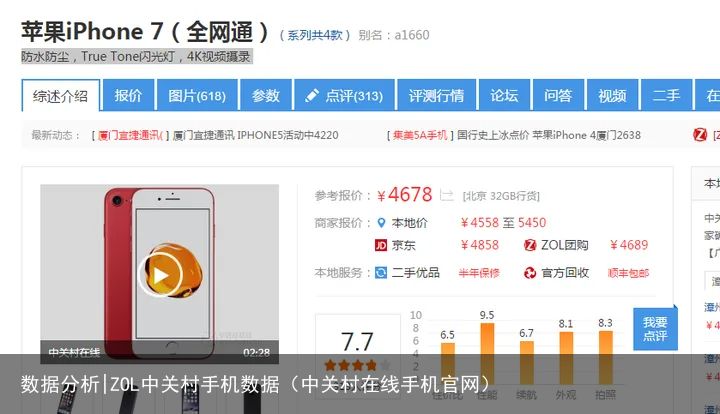
手机市场的消费状况
手机价格分布描述手机品牌生产产品种类描述手机品牌评论人数分析手机品牌聚类分析
1.1 手机价格分布描述
# import module
import pandas as pd
import numpy as np
import matplotlib.pyplot as plt
import seaborn
import math
from sklearn.cluster import KMeans
from mpl_toolkits.mplot3d import Axes3D
from wordcloud import WordCloud
from PIL import Image
from matplotlib import ch
ch.set_ch()
%matplotlib inline
# import data
table = pd.read_csv(C:\\Users\\Administrator\\Desktop\\zol_moblie.csv,encoding=gb2312)
# plot the distribution of price in total
num_bins = 90
fig, ax = plt.subplots(figsize=(9,5))
n, bins, patches = ax.hist(table["price"], num_bins, range = (50,5000))
ax.set_xlabel(Price)
ax.set_ylabel(Quatity)
ax.set_title(The distribution of price in total)
fig.tight_layout()
plt.show()
# caluculate the basic statistics of price
table["price"].describe()
# 手机价格的描述
count 2289.000000
mean 1468.736129
std 2100.270967
min 69.000000
25% 599.000000
50% 999.000000
75% 1769.000000
max 50000.000000
Name: price, dtype: float64
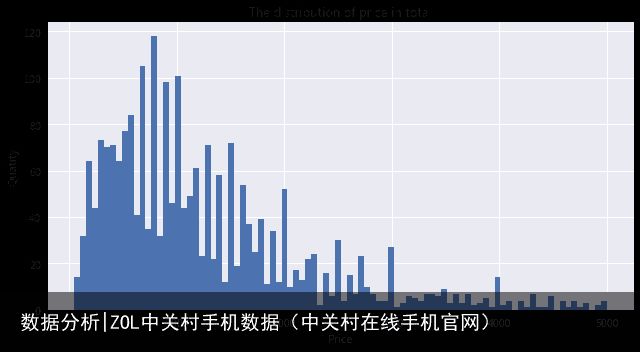
可以看出来大多数手机价格都在2000以下,均值在1500左右。商家喜欢设一些1899,2899之类的迷惑性价格。23333~
1.2 手机品牌生产产品种类描述¶
table1 = table.iloc[:,[0,2,78]]
table1 = table1.drop_duplicates(subset=[good_na])
grouped = table1.groupby(brand_name)
table2 = grouped[price].agg(np.count_nonzero)
table2 = table2.sort_values(axis=0)
fig, ax = plt.subplots(figsize=(13,6.5))
ax.set_xticks(np.linspace(0,70,8))
table2.plot()
ax.set_ylabel(number of goods)
ax.set_title(The number of goods in each brand)
plt.show()
print table2[0:40]
print table2[40:]
brand_name
21克 1
明基 1
汇威 1
独影天幕 1
uphone 1
manta 1
innos 1
VANO 1
小格雷 1
22克 1
23克 1
Ant 1
同洲 2
格力 2
步步高 2
COMIO 2
imoo 2
VEB 3
奇酷 3
8848 4
AGM 4
Google 4
SOYES 4
PPTV 4
蓝魔 4
一加 5
Lovme 5
锤子科技 6
富可视 7
MANN 7
360 8
松下 9
美图 10
乐视 10
SUGAR 11
大神 11
sonim 11
中国移动 11
Microsoft 11
先锋 13
Name: price, dtype: int64
brand_name
乐目 13
Acer 16
HP 16
苹果 17
魅族 21
荣耀 21
小米 25
努比亚 25
神舟 26
华为 29
夏普 30
长虹 30
HTC 36
华硕 41
黑莓 42
vivo 42
酷派 44
TCL 45
LG 47
诺基亚 48
OPPO 48
Moto 48
三星 49
中兴 52
酷比 53
联想 54
索尼 58
康佳 60
朵唯 62
邦华 62
海尔 63
天语 67
纽曼 69
海信 71
飞利浦 78
金立 81
Name: price, dtype: int64
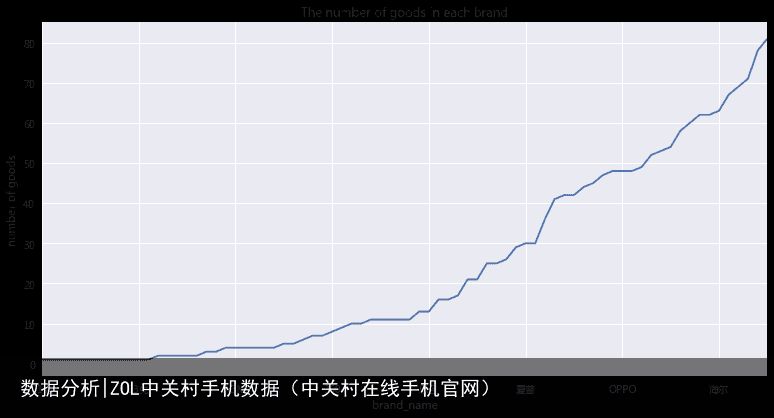
我们得到了手机品牌的商品量,苹果有17款,属于比较少的品牌了。最热门的OPPO,vivo,华为之类出产的商品都不是最多的。
1.3 手机品牌评论人数分析
table1 = table[["brand_name","good_na","pinglunrenshu"]]
table1 = table1.drop_duplicates(subset=[good_na])
table1 = table1.dropna()
# plot the distribution of pinglunrenshu in total
num_bins = 90
fig, ax = plt.subplots(figsize=(13,6.5))
n, bins, patches = ax.hist(table1["pinglunrenshu"], num_bins, range = (0,100))
ax.set_xlabel("pinglunrenshu")
ax.set_ylabel(Quatity)
ax.set_title(The distribution of pinglunrenshu in total)
fig.tight_layout()
plt.show()
table1["pinglunrenshu"].describe()
# get the distribution of pinglunrenshu in of each brand
grouped = table1.groupby(brand_name)
table2 = grouped["pinglunrenshu"].agg(np.mean)
table2 = table2.sort_values(axis=0)
# plot the distribution of pinglunrenshu in of each brand
fig, ax = plt.subplots(figsize=(13,6.5))
ax.set_xticks(np.linspace(0,70,8))
table2.plot()
ax.set_ylabel(number of pinglunrenshu)
ax.set_title(The number of goods in each brand)
plt.show()
print table2[0:40]
print table2[40:]
brand_name
21克 1.000000
Ant 2.000000
COMIO 2.000000
长虹 2.625000
小格雷 3.000000
Acer 3.636364
SOYES 4.500000
22克 5.000000
sonim 5.000000
HP 5.750000
Lovme 6.400000
汇威 8.000000
海尔 8.400000
邦华 9.389831
夏普 10.576923
Google 15.000000
AGM 16.000000
imoo 16.500000
纽曼 17.031250
康佳 17.809524
海信 21.431373
富可视 22.571429
MANN 22.714286
VEB 23.333333
先锋 29.846154
步步高 30.000000
manta 33.000000
酷比 33.510638
黑莓 33.731707
独影天幕 34.000000
PPTV 35.500000
飞利浦 36.476923
蓝魔 36.750000
8848 41.000000
TCL 41.860465
朵唯 42.236364
美图 46.600000
天语 51.607843
中兴 53.368421
酷派 57.928571
Name: pinglunrenshu, dtype: float64
brand_name
innos 59.000000
华硕 60.562500
明基 68.000000
同洲 68.500000
中国移动 73.181818
SUGAR 74.272727
乐目 96.363636
Microsoft 99.444444
联想 103.862745
神舟 109.800000
LG 126.409091
格力 137.500000
360 154.875000
Moto 171.354167
索尼 222.824561
金立 224.430380
小米 229.600000
奇酷 245.666667
华为 255.965517
三星 275.530612
努比亚 276.760000
诺基亚 293.270833
HTC 308.571429
锤子科技 353.000000
一加 397.200000
魅族 428.000000
乐视 449.900000
vivo 495.738095
荣耀 512.857143
OPPO 586.208333
苹果 710.529412
大神 793.636364
Name: pinglunrenshu, dtype: float64
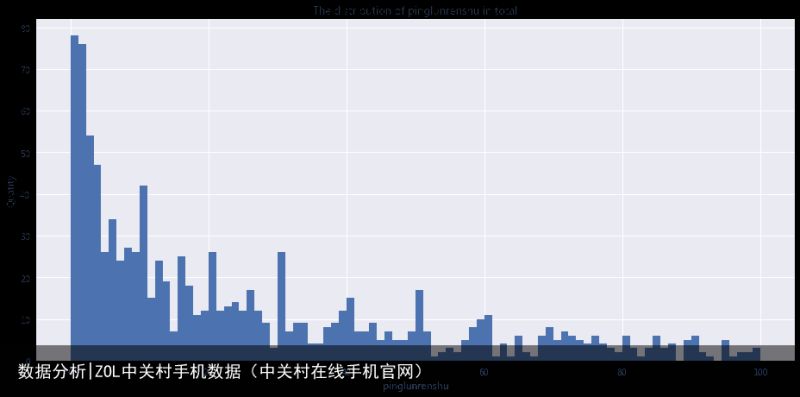
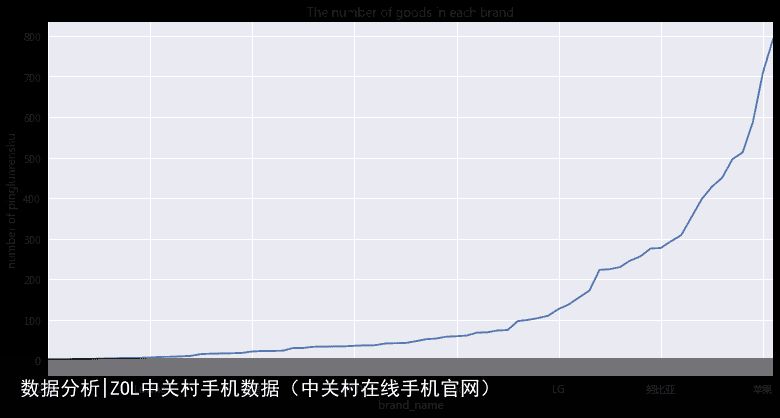
评论数量基本和他的销量以及热门程度成正比,我们看到评论最多的手机品牌基本都是我们耳熟能详的。
1.4 手机品牌聚类分析color_dict = {0:red, 1:orange, 2:yellow, 3:green, 4:cyan, 5:blue, 6:yellow}
# get the number of types of each brand, the median of brand price, the mean of review number
table2 = table.iloc[:,[0,2,78]]
table2 = table2.drop_duplicates(subset=[good_na])
grouped = table2.groupby(brand_name)
table2 = grouped[price].agg([np.count_nonzero,np.median])
grouped = table.groupby("brand_name")
table3 = grouped["pinglunrenshu"].agg([np.mean])
table4 = pd.concat([table2,table3],axis = 1)
# fill none with 0 and get the log of data
table4["count_nonzero"] = table4["count_nonzero"].map(lambda x: math.log(x))
table4["median"] = table4["median"].map(lambda x: math.log(x))
table4["mean"] = table4["mean"].map(lambda x: math.log(x))
table4 = table4.fillna(0)
# cluster all data
kmeans = KMeans(n_clusters=4, random_state=0).fit(table4.values)
table4[kind] = kmeans.labels_
table5 = table4[kind]
# get the label of data
la = kmeans.labels_
# plot the result of cluster
fig = plt.figure(figsize=(12,7))
ax = fig.add_subplot(111, projection=3d)
xs = table4["count_nonzero"].values
ys = table4["median"].values
zs = table4["mean"].values
for i in range(len(xs)):
ax.scatter(xs[i], ys[i], zs[i], c=color_dict[la[i]])
for i in kmeans.cluster_centers_:
ax.scatter(i[0], i[1], i[2], c=k)
ax.set_xlabel(good_kind)
ax.set_ylabel(median_)
ax.set_zlabel(mean)
ax.set_title(The cluster of brand)
plt.show()
print table5.sort_values()[0:32]
print table5.sort_values()[32:]
brand_name
独影天幕 0
imoo 0
innos 0
PPTV 0
美图 0
蓝魔 0
manta 0
MANN 0
奇酷 0
步步高 0
VEB 0
格力 0
明基 0
AGM 0
8848 0
富可视 0
同洲 0
Google 0
uphone 1
sonim 1
松下 1
小格雷 1
汇威 1
21克 1
COMIO 1
SOYES 1
22克 1
Lovme 1
23克 1
Acer 1
VANO 1
Ant 1
Name: kind, dtype: int32
brand_name
飞利浦 2
康佳 2
朵唯 2
纽曼 2
酷派 2
海信 2
海尔 2
酷比 2
邦华 2
长虹 2
天语 2
黑莓 2
夏普 2
HP 2
TCL 2
先锋 2
中兴 2
苹果 3
荣耀 3
Moto 3
诺基亚 3
Microsoft 3
LG 3
HTC 3
金立 3
锤子科技 3
360 3
联想 3
OPPO 3
索尼 3
大神 3
神舟 3
vivo 3
一加 3
三星 3
中国移动 3
乐目 3
乐视 3
魅族 3
小米 3
华为 3
华硕 3
SUGAR 3
努比亚 3
Name: kind, dtype: int32
2. 消费者对于手机每一种性能的关注度¶
评论云图性能评分与总评分的回归
2.1 评论云图
table1 = table.iloc[:,18:76]
table2 = np.append(table1.iloc[:,0:2].values, table1.iloc[:,2:4].values, axis = 0)
for i in range(13):
table2 = np.append(table2, table1.iloc[:,i*2+4:i*2+6].values, axis = 0)
table2 = pd.DataFrame(table2)
table2 = table2.dropna(axis=0, how=any, subset=[0,1])
table2 = table2.drop(axis=0, labels=[4610,7782,10071,12360,14649,915,3204,5493])
table2[1] = table2[1].map(lambda x: -float(x))
grouped = table2.groupby(0,as_index = False)
table3 = grouped[1].agg(np.sum)
table3 = table3.drop(axis=0, labels=[5,25,17,27,52,53,68,79,100,116,125,32,49,
54,71,80,34,74,111,123,0,129,114,36,93,109,105,
115,48,83,66,104,128,57,84,124,64,20,11,23,
55,10,16,35,51,15,108,94,72,56,63,42,97,47,132,61,
120,24,90,13,7,89,76,4,122,101])
d = {}
for a, x in table3.values:
d[a] = x
cloud = WordCloud(
#设置字体,不指定就会出现乱码
font_path="C:\\Users\\Administrator\\Desktop\\vistab.ttf",
#设置背景色
background_color=white,
#最大号字体
max_font_size=60
)
cloud.generate_from_frequencies(frequencies=d)
plt.figure(figsize=(11,6.5))
plt.imshow(cloud, interpolation="bilinear")
plt.axis("off")
plt.show()
table4 = np.append(table1.iloc[:,18:20].values, table1.iloc[:,20:22].values, axis = 0)
for i in range(27):
table4 = np.append(table4, table1.iloc[:,i*2+4:i*2+6].values, axis = 0)
table4 = pd.DataFrame(table4)
table4 = table4.dropna(axis=0, how=any, subset=[0,1])
table4 = table4.drop(axis=0, labels=[4610,7782,10071,12360,14649,5493])
table4[1] = table4[1].map(lambda x: -float(x))
grouped = table4.groupby(0)
table5 = grouped[1].agg(np.sum)
table5 = table5.drop(axis=0, labels=list(table3[0].values))
cloud = WordCloud(
#设置字体,不指定就会出现乱码
font_path="C:\\Users\\Administrator\\Desktop\\vistab.ttf",
#设置背景色
background_color=white,
#最大号字体
max_font_size=60
)
cloud.generate_from_frequencies(frequencies=table5.to_dict())
plt.figure(figsize=(11,6.5))
plt.imshow(cloud, interpolation="bilinear")
plt.axis("off")
plt.show()云图的分析结果太显而易见,我就不啰嗦了。
2.2 性能评分与总评分的关系
otable <- read.csv("C:\\Users\\Administrator\\Desktop\\zol_regresion.csv")
co_regresion <- function(t){
table <- otable[otable$kind==t,]
table <- table[4:9]
table$pingfen<-as.numeric(table$pingfen)
table$xingjiabi<-as.numeric(table$xingjiabi)
table$xingneng<-as.numeric(table$xingneng)
table$xuhang<-as.numeric(table$xuhang)
table$waiguan<-as.numeric(table$waiguan)
table$paizhao<-as.numeric(table$paizhao)
fit <- lm(pingfen ~ xingjiabi+xingneng+xuhang+waiguan+paizhao,data = table)
summary(fit)
pairs(~ pingfen+xingjiabi+xingneng+xuhang+waiguan+paizhao,data=table)
summary(fit)
}
co_regresion(0)
co_regresion(1)
co_regresion(2)
co_regresion(3)
Call:
lm(formula = pingfen ~ xingjiabi + xingneng + xuhang + waiguan +
paizhao, data = table)
Residuals:
Min 1Q Median 3Q Max
-1.40476 -0.11559 -0.02908 0.12152 1.06056
Coefficients:
Estimate Std. Error t value Pr(>|t|)
(Intercept) 0.861774 0.262504 3.283 0.00176 **
xingjiabi 0.241649 0.041727 5.791 3.15e-07 ***
xingneng 0.144299 0.024588 5.869 2.36e-07 ***
xuhang 0.240590 0.045289 5.312 1.86e-06 ***
waiguan -0.003125 0.003495 -0.894 0.37499
paizhao 0.033827 0.004532 7.463 5.38e-10 ***
---
Signif. codes: 0 *** 0.001 ** 0.01 * 0.05 . 0.1 1
Residual standard error: 0.3632 on 57 degrees of freedom
Multiple R-squared: 0.9185, Adjusted R-squared: 0.9113
F-statistic: 128.5 on 5 and 57 DF, p-value: < 2.2e-16
Call:
lm(formula = pingfen ~ xingjiabi + xingneng + xuhang + waiguan +
paizhao, data = table)
Residuals:
Min 1Q Median 3Q Max
-0.50720 -0.22837 -0.02607 0.11355 1.13510
Coefficients:
Estimate Std. Error t value Pr(>|t|)
(Intercept) 1.0257797 0.4618581 2.221 0.04828 *
xingjiabi 0.2727387 0.1104591 2.469 0.03117 *
xingneng 0.0399278 0.0920517 0.434 0.67285
xuhang 0.1898382 0.0807936 2.350 0.03851 *
waiguan -0.0001643 0.0080033 -0.021 0.98399
paizhao 0.0447016 0.0107835 4.145 0.00163 **
---
Signif. codes: 0 *** 0.001 ** 0.01 * 0.05 . 0.1 1
Residual standard error: 0.4846 on 11 degrees of freedom
Multiple R-squared: 0.9537, Adjusted R-squared: 0.9327
F-statistic: 45.32 on 5 and 11 DF, p-value: 5.678e-07
Call:
lm(formula = pingfen ~ xingjiabi + xingneng + xuhang + waiguan +
paizhao, data = table)
Residuals:
Min 1Q Median 3Q Max
-1.32028 -0.28509 -0.06264 0.20548 1.66519
Coefficients:
Estimate Std. Error t value Pr(>|t|)
(Intercept) 0.645456 0.082558 7.818 3.01e-14 ***
xingjiabi 0.357501 0.014128 25.305 < 2e-16 ***
xingneng 0.196706 0.010172 19.338 < 2e-16 ***
xuhang 0.262912 0.012348 21.292 < 2e-16 ***
waiguan 0.001259 0.001182 1.065 0.287
paizhao 0.014123 0.001274 11.088 < 2e-16 ***
---
Signif. codes: 0 *** 0.001 ** 0.01 * 0.05 . 0.1 1
Residual standard error: 0.4201 on 519 degrees of freedom
Multiple R-squared: 0.9235, Adjusted R-squared: 0.9228
F-statistic: 1253 on 5 and 519 DF, p-value: < 2.2e-16
Call:
lm(formula = pingfen ~ xingjiabi + xingneng + xuhang + waiguan +
paizhao, data = table)
Residuals:
Min 1Q Median 3Q Max
-1.3024 -0.1779 -0.0255 0.1301 2.8632
Coefficients:
Estimate Std. Error t value Pr(>|t|)
(Intercept) 1.3206495 0.0767623 17.204 < 2e-16 ***
xingjiabi 0.2553044 0.0108063 23.626 < 2e-16 ***
xingneng 0.1273658 0.0058837 21.647 < 2e-16 ***
xuhang 0.2548168 0.0099166 25.696 < 2e-16 ***
waiguan 0.0037196 0.0008924 4.168 3.31e-05 ***
paizhao 0.0221485 0.0009536 23.227 < 2e-16 ***
---
Signif. codes: 0 *** 0.001 ** 0.01 * 0.05 . 0.1 1
Residual standard error: 0.3665 on 1124 degrees of freedom
Multiple R-squared: 0.8585, Adjusted R-squared: 0.8579
F-statistic: 1364 on 5 and 1124 DF, p-value: < 2.2e-16


 可以看出来大多数手机价格都在2000以下,均值在1500左右。商家喜欢设一些1899,2899之类的迷惑性价格。23333~
可以看出来大多数手机价格都在2000以下,均值在1500左右。商家喜欢设一些1899,2899之类的迷惑性价格。23333~ 我们得到了手机品牌的商品量,苹果有17款,属于比较少的品牌了。最热门的OPPO,vivo,华为之类出产的商品都不是最多的。
我们得到了手机品牌的商品量,苹果有17款,属于比较少的品牌了。最热门的OPPO,vivo,华为之类出产的商品都不是最多的。
 评论数量基本和他的销量以及热门程度成正比,我们看到评论最多的手机品牌基本都是我们耳熟能详的。
评论数量基本和他的销量以及热门程度成正比,我们看到评论最多的手机品牌基本都是我们耳熟能详的。







![[众诚云网科技]](/uploads/allimg/20190305/c4b08346cbe8b0efae6b132139c2d72a.png)
 2023-05-29
2023-05-29 浏览次数:次
浏览次数:次 返回列表
返回列表